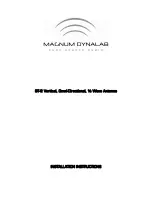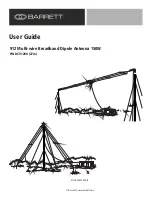
•
Do not work in high wind or rain, or if a storm, lightning, or other
adverse weather conditions are present or approaching.
•
Do not attempt to assemble, move, or mount the antenna on a windy
day. Even a slight wind can unexpectedly create sudden strong forces on
the antenna surface.
Antennas that have been improperly installed or attached to an unstable
structure are susceptible to wind damage, which can be very serious or even
life threatening to you and the customer. The installer and the dealer assume
full responsibility that the installation is structurally sound to support all loads
(weight, wind, and ice) and is properly sealed against leaks.
Properly ground the antenna assembly in accordance with all local and
national electrical codes.
Observe these precautions to avoid exposure to RF radiation, a potential
safety hazard:
•
All antennas must carry an industry-standard and government-approved
Radiation Hazard Caution
label on the feed support arm.
•
The antenna must be installed in a location not readily accessible to
children and in a manner that prevents human exposure to potentially
harmful levels of radiation.
•
Antennas mounted in the continental United States, Puerto Rico, or a
site with an elevation angle that is 30° or greater must be installed such
that the lower lip of the reflector is at least 4 ft 5 inches above any
surface upon which a person might be expected to stand, and 3 ft 3
inches from any opening (such as a door or window) in a building or
adjacent structure.
•
Antennas mounted in Canada, Alaska, Hawaii, or with a less than 30°
elevation must be installed such that the lower lip of the reflector is at
least 5 ft above any surface upon which a person might be expected to
stand, and 3 ft 3 inches from any opening (such as a door or window) in
a building or adjacent structure.
8
Antenna installation safety
1039384-0001 Revision C









































